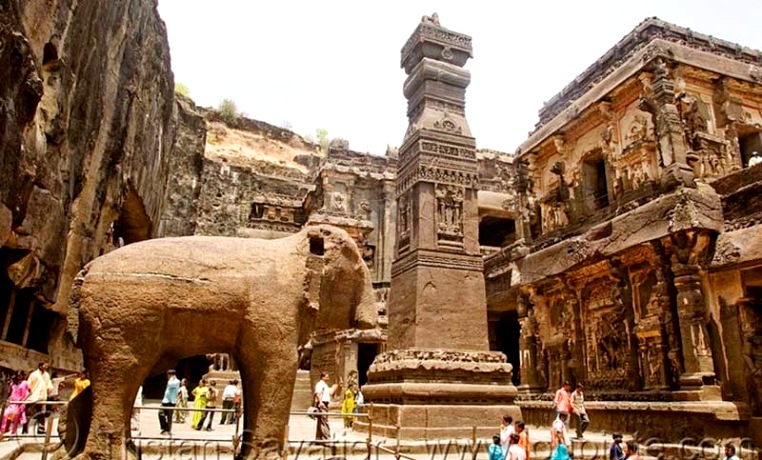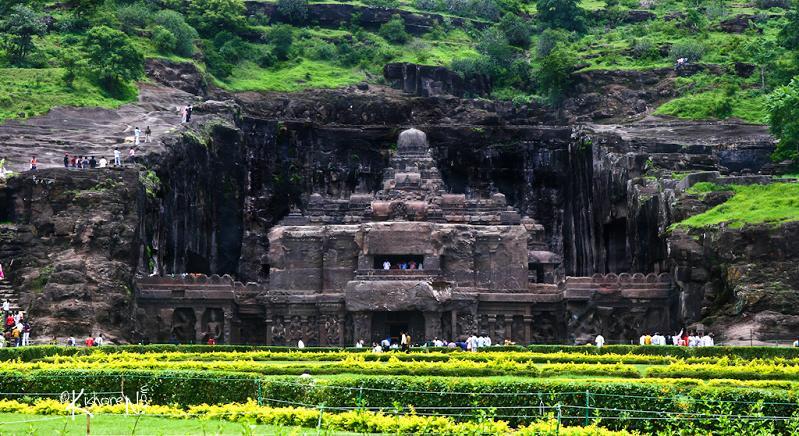
Ellora Caves in Maharashtra- One of the most popular UNESCO World Heritage Sites in India, Ellora caves are also known as Verul. Dating back to the 6th and 10th century, these are a group of Hindu, Buddhist and Jain caves. These stunning man-made monolithic cave temples were carved during the rule of Kalachuri, Rashtrakuta and Chalukya dynasties. UNESCO inscribed the heritage site in the year 1983. There are a total of 34 caves temples. These comprise of 17 Hindu, 12 Buddhist, as well as 5 Jain caves, and are a proof of religious harmony prevalent in those times. Extending over 2 km, these caves are a display of architectural marvel of ancient India.
It is believed that the Ellora caves in Aurangabad were carved out from the vertical side of the Charanandri hills, between the duration of 6th century and 10th century. History states that after the Ajanta Caves, which are located 100 km north-eastwards, were deserted, the carving work of these caves started around 550 AD. It is said that the estimated dates of the caves coincide with the timing of the decline of Buddhism in India and reinstating of Hinduism. The Chalukya and Rashtrakuta rulers were great patrons of the Brahmanical movement, under whom most of the work of Ellora caves was done, including the most popular 7th century Kailasa temple. A set of caves was built during the 10th century. This was the time when the local rulers, converted from Shaivism (the followers of Lord Shiva) to the Digambara sect of Jainism. The prime reason of these caves being in the UNESCO list is that religious harmony that has been displayed here.
Archaeologists state that these caves were carved out from the basalt volcanic eruptions that occurred some 65 million years ago. This lava flow formation, came to be known as Deccan Trap and have way to these caves that were peculiar of Deccan topography.
Temples
Kailasa Temple- Also known as Kailasnath Temple, Kailasa temple is the main attraction of Ellora. It is the largest rock-cut cave that has been made from a single rock. The wonderful Dravidian style of architecture dedicated to Lord Shiva was completed in about 150 years.
Kailasa temple has a courtyard that is U-shaped where you can see structures of god and goddess, on the sculpted side panels. There is also an idol of Nandi bull, in front of the Shiva Lingam, in the main courtyard. Another brilliant idol is of Ravana, lifting the Mount Kailas, with Goddess Parvati and Lord Shiva seated on a throne.
Caves
Ellora caves can be segregated into- Buddhist Caves: Dating between 5th and 7th centuries, the Buddhist caves are the earliest ones of the group. These caves have monasteries, along with other structures like living spaces as well as kitchens of the monks, made from hill-rocks.
Hindu Caves- Carved in the starting of the 7th century, the Hindu caves are equally wonderful. These cave complexes have wonderful designs and are great piece of planning with superb implementation.
Jain Caves- Though not as huge as the other two caves, but the Jain caves are a wonderful display of Jain religious philosophy. Elaborate artwork is the highlight of these caves.
Need Aspark Help?
For Tour Packages, Vehicle Rental and Customer Care Support.
+91 9999 31 7846
booking@asparkholidays.comWhy Travel with Us?

Excellent Support
Our Team Available 24x7 for Customer support
Best Price & Savings
We Offer the Most Competitive Prices.

